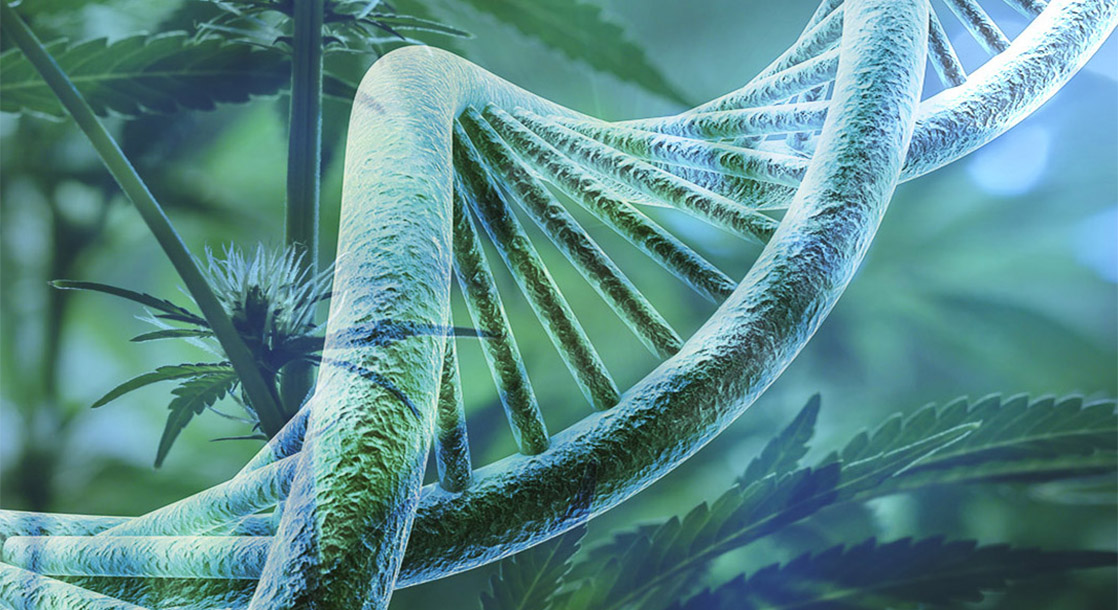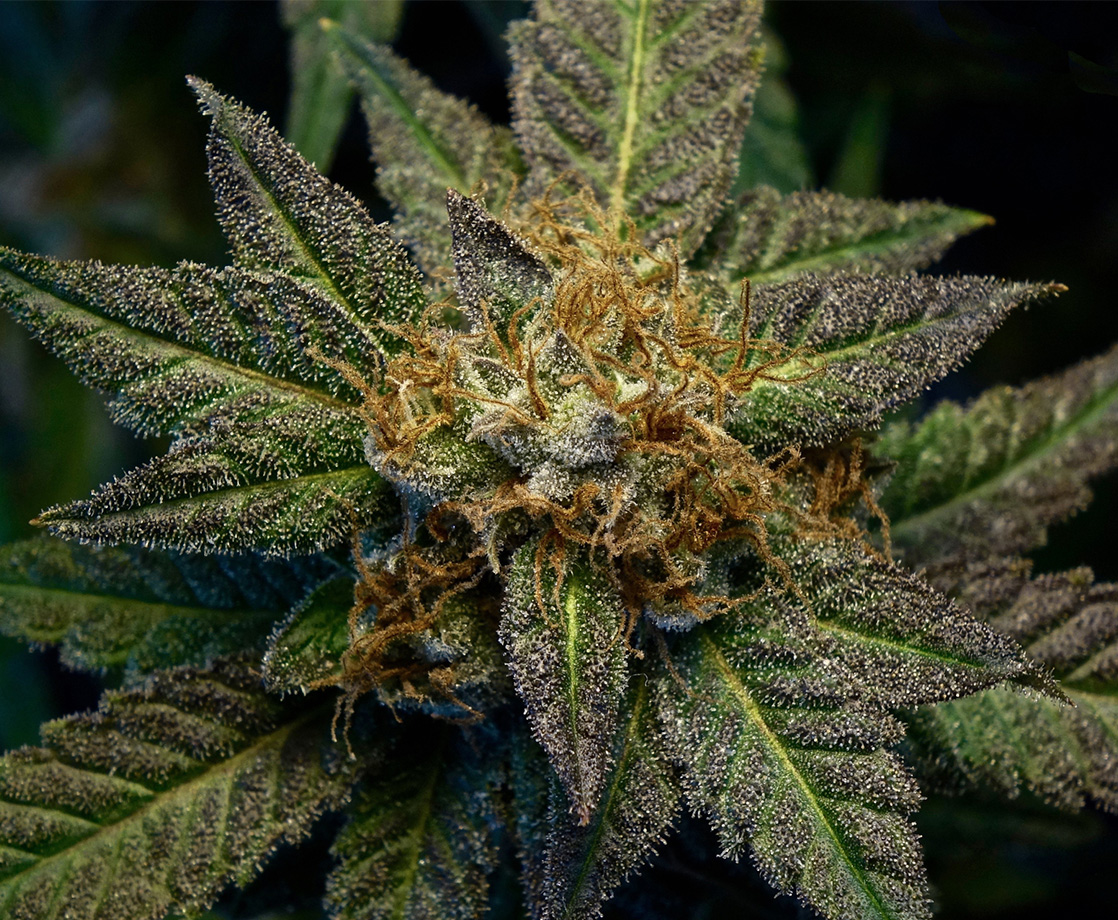Well, after years of sensationalist false alarms, it’s finally here: genetically modified cannabis for the commercial market.
Created by Trait Biosciences, the world’s first truly transformed marijuana plant has arrived. A cannabis biotech firm based in Los Alamos, New Mexico, Trait designed the plant to produce water-soluble cannabinoids, which they claim confers several industrial benefits that companies can’t get from the naturally bred plant.
Conventional techniques to create water-soluble cannabinoids — cannabinoids like CBD and THC that can dissolve in water — usually involve emulsifying cannabis extracts, which is basically mixing them into starches. Trait’s proprietary plants generate the dissolvable cannabinoids inside of the cannabis itself, so there’s no need to chemically modify the molecules after costly and hazardous extraction processes.
But, before we dive into this biotechnological marvel (or Dankenstein, depending on how you feel about genetic modification), let’s review what makes something genetically modified (GM) and what doesn’t.

Trait Biosciences headquarters in Los Alamos, New Mexico. Image courtesy of Trait Biosciences.
A Primer on Genetic Engineering
Less biotech-savvy cannabis activists will claim that GM weed has been on the market for years, often parroting the same “naturalistic” claims invented by the biotech industry itself. According to this (erroneous) belief, nature has essentially been “genetically modifying” plants since, well, forever. But that’s not true. Frankly, that’s a marketing line invented to make the public more amenable to GM crops.
In the sciences (not private industries), genetic modification or engineering refers to artificial methods of splicing either human-made genes or genes from foreign organisms into another living being. Genetic modification can also refer to “shotgun” techniques, where an organism is showered in radiation or metallic pellets that carry the genes in question. Novel life forms created this way are called genetically modified organisms, or GMOs.
People often confuse GMOs with artificially selected organisms. Examples of artificial selection, or selective breeding, include domesticated dogs or certain crops like berries, broccoli, bananas — and cannabis. Artificial selection uses cross-breeding techniques to amplify desired genes in an organism’s offspring, usually through inbreeding, but not always.
Regardless of how artificial selection is performed, it always relies on traditional breeding techniques (e.g. pollinating flowers, getting two dogs to mate), and it never introduces foreign or human-made genes into the parents or their offspring.
Genetic modification or engineering, on the other hand, does not use traditional breeding techniques. Done in a laboratory environment, organisms are subject to highly sophisticated methods that weave foreign genes into their DNA. If the organism can pass on those foreign genes to its offspring, we say the organism is “fully transformed.”
How Trait Biosciences’ Weed Plant Is Different
Trait’s patent-pending cannabis plant could have major implications for the burgeoning cannabis industry. In agriculture, GM crops are usually designed to resist pesticides, herbicides, or extreme environmental conditions. Instead, Trait has introduced a cannabis plant that fundamentally alters the chemical composition of its most valued components: the cannabinoids.
“To our knowledge, this is the first truly stabilized, ‘transformed’ cannabis plant,” Ronan Levy, Trait’s Chief Strategy Officer, told MERRY JANE during a phone interview. “There have been transient ones, but the genes have not passed down to further generations.”
One of these transformation attempts happened in 2012. A research group led by Dr. Imane Wahby, PhD, used agrobacterium to introduce foreign genes into cannabis plant tissue, namely the roots. Although the foreign genes made it into the tissue’s DNA, the genes likely couldn’t pass on to offspring (a “transient transformation,” as Levy called it). That’s probably because cannabis evolved to maintain its internal genetics, and plants that can self-pollinate by becoming hermaphrodites (like weed) often circumvent attempts to fully transform them.
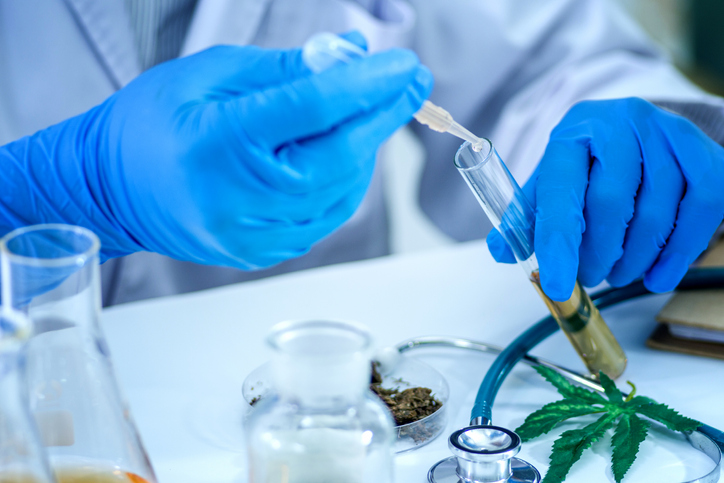
Trait’s water-soluble cannabis technology falls under two product lines, Trait Distilled and Trait Amplified. Trait Distilled focuses on crafting edible and drinkable products using the company’s water-soluble cannabinoids. Trait Amplified refers to the GM plants themselves.
Trait has more product lines, too. Trait Defense uses biotechnological methods to protect its cannabis from viruses, bacteria, and molds. Trait Tailored offers customized cannabis that produces specific cannabinoids levels or ratios, e.g. plants that always crank out 30 percent THC, or weed that always balances a 1-to-1 THC-to-CBD ratio. And the company’s Trait Zero line promises hemp plants that never produce THC, period.
Levy credits the success of Trait’s GM plants to Dr. Richard Sayre, the company’s Chief Science Officer. You’ve probably never heard of Sayre, but within the agricultural science community, the guy is a legend. Much of his groundbreaking work focused on harnessing electricity from algae, but now Dr. Sayre has brought his biotechnological prowess to the cannabis scene.
Sayre “realized when the plant synthesizes cannabinoids, there’s a toxic element to it,” Levy continued. “There’s a reason why they’re only synthesized in the bud and stored in the trichomes. Production of cannabinoids is toxic to the plant.” Normally, cannabis produces the bulk of its cannabinoids and terpenes in the bud’s trichomes, which are oily sacs that grow along and inside of the flowers. This is because both cannabinoids and terpenes are naturally fat-soluble, meaning they dissolve in fats or oils. If these fat-soluble cannabinoids and terpenes were made in the plant’s stems, leaves, etc., it could compromise the plant’s health by affecting its ability to absorb carbon dioxide, release oxygen, or transpire water — the plant version of sweating.
While Levy’s previous statement may offend some folks’ pro-cannabis sensibilities, it’s true. Previous research shows that if cannabis cells are exposed to unnaturally concentrated amounts of cannabinoids, they will die. As toxicologists say, toxicity has little to do with a molecule’s nature and much more to do with the dose. After all, drinking too much water can be toxic to the human body, even though 70 to 80 percent of our bodies are composed of water.

According to a patent filing, Trait’s lab team laid out how mutant genes for an enzyme called cytochrome P450 — the same enzyme that breaks down drugs in our livers — and a glycosyltransferase enzyme could convert cannabinoids into water-soluble form within the cannabis plant itself. When the mutant glycosyltransferase binds to a cannabinoid like CBD, it attaches a simple sugar molecule to the cannabinoid through a process called glycosolation. Cannabinoids rocking this sugar attachment are called glycosolated cannabinoids. This development had several consequences for the plant and Trait’s manufacturing processes, with just one being cannabinoids that dissolve in water.
“If you glycosylate the cannabinoids in the plant, you can detoxify the cannabinoid synthesis process,” Levy said, “which potentially enables the plant to synthesize and store cannabinoids in every cell of the plant, not just the trichomes.”
In other words, Levy is saying that every part of Trait’s cannabis plants could produce cannabinoids. This includes the leaves, stems, and roots. And since cannabis doesn’t rely on cannabinoids for its sustenance, Levy contends that these glycosolated compounds don’t compromise the plant’s health or survivability.
Levy also argues that because Trait’s plants produce cannabinoids inside and outside of the flower’s trichomes, they can generate greater cannabinoid yields than traditionally bred plants, up to five times more. The company extracts the glycosolated cannabinoids from the plant material using an industrial press, the same technique used to get sugar out of sugarcane.
“You don’t have to wait for the flowering phase to harvest the plant,” he said. “So the growth cycle is shorter. And because [the cannabinoids are] growing in stalks, stems, roots, and leaves, in theory, you can adopt a continuous harvest approach — taking off leaves and stalks from a plant without having to start with a new plant.”
Basically, Trait’s GM plants could be farmed for their cannabinoids in virtual perpetuity, since the initiation of the flowering stage is what ultimately tells the plant to die sometime in its near future. Theoretically, this same setup should work for THC as it does for CBD, but for now, Trait is only focusing on CBD.
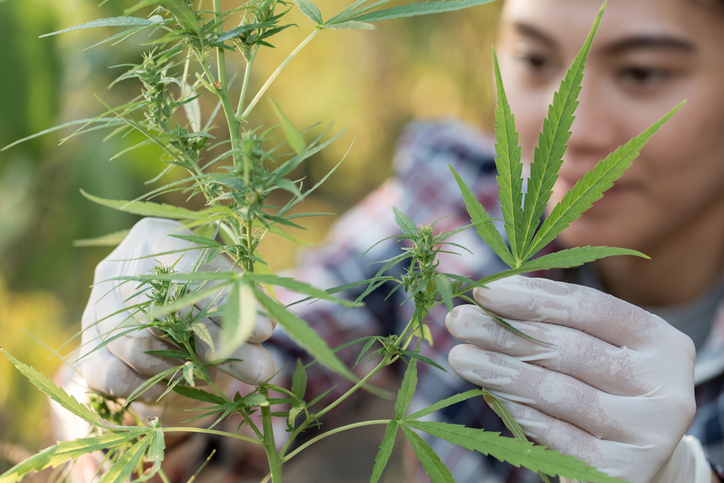
What’s the Point of Making Water-Soluble Cannabinoids?
Trait’s GM plants are ideal for crafting drinkables, or beverage products that contain cannabinoids like CBD or THC. Drinkables already exist, but companies currently make them by using high-pressure homogenization (as is done with milk), sonication (sound waves), or emulsification (mixing cannabinoids with starches) to get the cannabis extract to disperse in water.
But some companies have made cannabinoids dissolve better than others. While some weed beverages are “shelf-stable,” meaning cannabinoids remain suspended and invisible in water, others aren’t so efficient. For instance, you may notice that in some drinkables, the extract collects at the bottom of the bottle or the drink will appear cloudy when shaken. Levy explained that drinkables made from Trait Amplified’s cannabinoids would contain truly 100 percent water-soluble cannabinoids — no shaking required.
Furthermore, Levy said the most popular method of infusing drinkables could carry some health risks — risks he claims may not be present in Trait’s products.
“Nanoemulsification [is usually used] to create clear [cannabis] beverages, but using nanotechnology opens up a whole host of health concerns,” he said. “Concerns range from nanoparticles crossing the blood-brain barrier, getting into the thyroid gland, et cetera. That tech can be very useful, for instance, for getting drugs to specific cancer cells. But in food products, or in the case of cannabis products, you really have to question if nanotechnology is safe enough just to have a clear beverage.”
And if you’re wondering if you can get high from smoking or eating Trait’s weed leaves or roots, Levy said the company hasn’t tested that in human subjects — yet. But other research on orally ingested glycosolated THC and CBD show that these compounds rapidly hit the brain within minutes, with peak effects subsiding after about an hour and a half. That’s roughly the same psychoactive timeline of an alcohol buzz — which, right now, is the final goal for every drinkables manufacturer: to create a weed beverage that kicks in and wears off in the same manner as booze.
How Did Trait Biosciences Create These Plants?
Several methods exist for genetically modifying plants. To transform cannabis, plants can be exposed to chemicals that generate random mutations in the DNA, have foreign genes shot into them with tiny metallic pellets, or have their genes tweaked with newer splicing technologies like TALENs or CRISPR. According to Trait’s scientists, Dr. Sayre’s group relied on one of the first and most reliable methods for genetically modifying weed: agrobacterium.
Agrobacterium refers to a genus, or generalized group, of bacteria known for causing tumors in plants. The bacteria do this by inserting their DNA, or plasmids, into the host plant. In the ’70s, scientists realized if they deleted the tumor-causing portion of the bacterial plasmid, they could splice other genes into the agrobacterium, essentially turning the microorganisms into minature machines that can alter a plant’s DNA.
But is Trait Biosciences the first team to fully transform cannabis? To find out, MERRY JANE spoke with Dr. Darryl Hudson, PhD, a cannabis geneticist who cofounded InPlanta Biotechnology, a cannabis breeding company, with another weed scientist, Dr. Igor Kovalchuk.
“I don’t believe that it’s true,” Hudson said about Trait’s claim to being the first. “I believe other people have done it, just not necessarily published it or patented it. Some of us are a little more quiet about the things we’ve been doing.”
Hudson and Kovalchuk both belong to this camp of quiet inventors. Hudson first performed gene-knockouts — “turning off” genes so they don’t express themselves in the plant — in 2005. For the past 13 years, he and his business partner have altered cannabis DNA using a variety of methods, including agrobacterium.
“My issue, though, is who cares who was first?” Hudson continued. “In cannabis, everyone wants to be the first and the biggest, the baddest, the best. And to what end? At the end of the day, the person who grows the most cannabis and helps the most people, those are the ones who are going to win.”
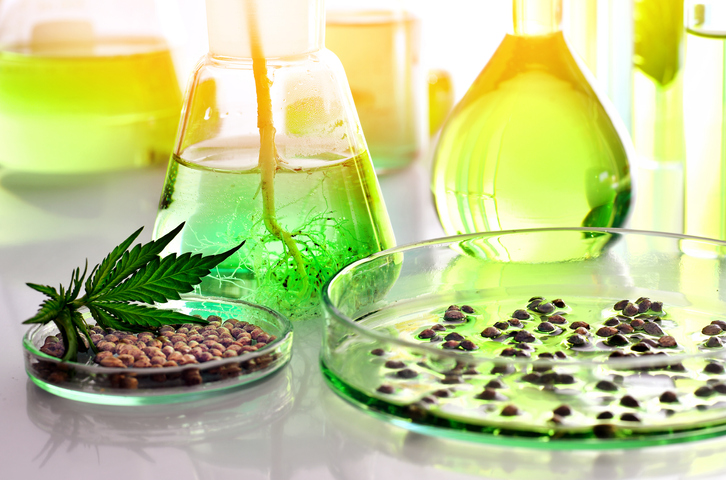
Hudson wasn’t convinced that Trait’s market strategy, to infuse water-soluble cannabinoids into edibles and beverages, is a great use of genetic modification, either. “It’s just interesting that a lot of people make assumptions in cannabis about what people will want, like water-soluble cannabinoids. I read that, and I laugh at it. There’s a dispensary in California that’s carried weed drinks for a while, and they found that people don’t like drinking cannabinoids,” he said.
“Nobody wants to be falling off their stool ten minutes after they showed up at the bar. That’s what’s going to happen,” he added, referring to the higher bioavailabity and activity of water-soluble cannabinoids. “When you’re drunk, your friends can carry you home, so you can sleep it off. Now, you’ve got to carry someone home who’s also got strong anxiety and paranoia? It’s not going to be a fun experiment.”
Hudson did agree with Levy’s assessment that glycosolated cannabinoids may enhance the effectiveness of certain cancer treatments, as researchers could modify water-soluble cannabinoids to target specific organs or tissues, delivering cannabis medications directly to a patient’s cancer cells. However, Hudson argued that terpenes, not cannabinoids alone, are more important for cannabis’s medical efficacy.

Regardless of who did what first, or for what purpose, Trait Biosciences can stake the claim on providing the first genetically modified weed plants for the commercial market. Or, at the very least, Trait is the first to openly admit such. And for anyone concerned that the company’s water-soluble genetics may accidentally escape and spread to other cannabis outside of its secured facility, Trait assured MERRY JANE that wasn’t likely.
“There are a number of well-established protocols and practices that we use to ensure that plants do not propagate in the wild,” Levy wrote in a follow-up email, “including male-sterile pollen that is under the control of a gene switch.” In other words, Trait’s plants don’t produce viable pollen, so they can’t reproduce sexually, which otherwise could spread Trait’s specialized genes to other, non-Trait cannabis plants. To generate new plants carrying the modified genes, someone would need to tissue culture or clone Trait’s cannabis. Theoretically.
In the past, there have been a few instances of GM crops (not Trait’s) contaminating the genetics of other, non-modified crops. This happens when the GM plants’ pollen was carried by the wind, such as from trucks transporting the GM plants. Completely containing Trait’s Amplified plants down to the genetic level may seem like a lot of work just to make weed molecules that dissolve in water. Yet genetically modifying the plant itself could be more cost-effective than other biotechnological approaches to making water-soluble weed, like using GM yeast or E. coli.
“Yeast is inefficient” for producing cannabinoids, Dr. Phillipe Henry, PhD, the Chief Science Officer at VSSL, a North American cannabis genomics firm, told MERRY JANE over the phone. “That’s probably why [Trait Biosciences] switched to this system.
“It’s possible to have an entire plant producing glycosolated cannabinoids,” Henry continued, “but I don’t see much commercial appeal on the recreational marijuana side.” Like Hudson, Henry doesn’t see bankable market potential in drinkables, either.
Although many cannabis activists rabidly tout the plant’s medicinal benefits, Trait is keeping mum on Amplified’s potential medical applications, if any exist. Meanwhile, on the recreational side, drinkables remain one of the least popular sectors of the regulated cannabis industry. Perhaps that will change as prohibition fades and the culture progresses. Or, maybe it won’t.
But one thing is certain: GMO weed is now a thing. Purists may protest, but I’ll drink to that.
Follow Randy Robinson on Twitter


